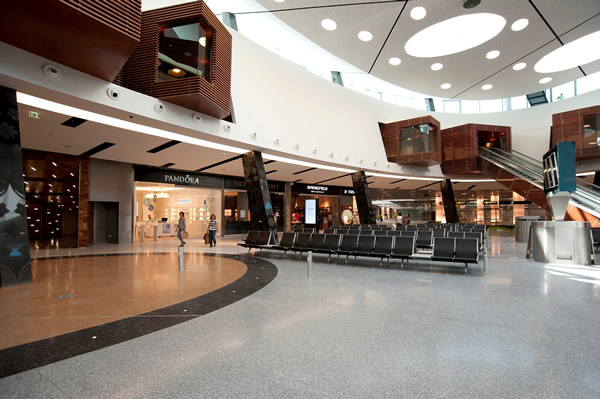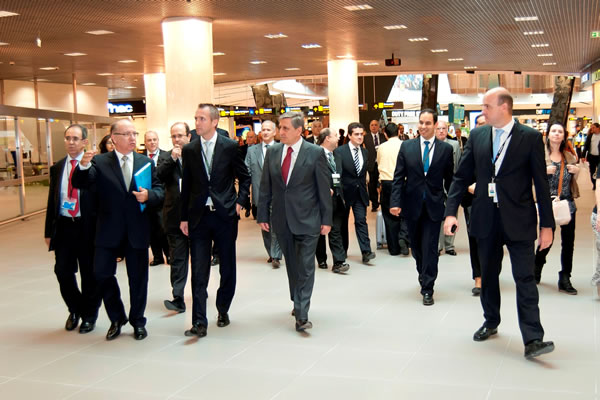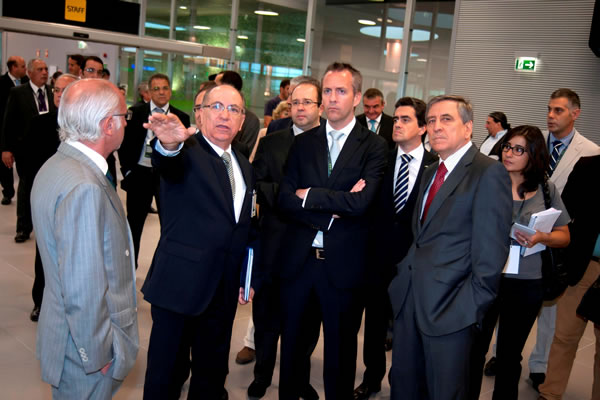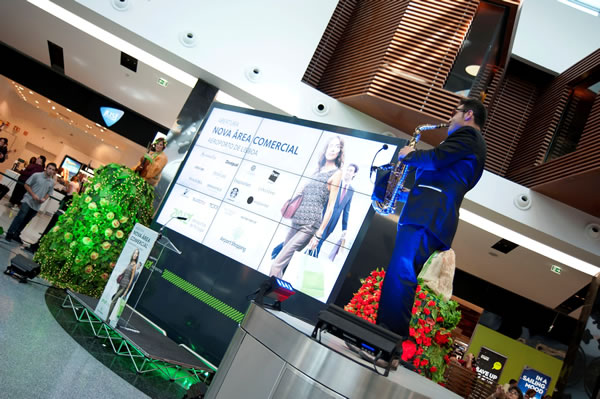PORTUGAL. Lisbon Airport opened its new International and Transit Terminal this week, unveiling a 2,000sq m commercial area comprising 20 new stores from leading international chains. This commercial expansion is said to represent a hundred new jobs and an estimated sales turnover of €15 million per year.
Located in the restricted departure areas of the airport, the new retail area includes the following stores: Accessorize, Desigual, Dreams Gourmet, FNAC, Geox, Hediard (the retailer’s first store in Portugal), Imaginarium, L’Occitane, Pandora, Springfield, Starbucks, Sunglass Hut, Swarovski, Swatch, Tumi, Victoria’s Secret (the retailer’s first store in the Iberian Peninsula) and Women’ Secret.
Passengers departing from Terminal 1 will now be offered a wider range of fashion and accessories, jewellery, books, toys, perfumery, cosmetics and gourmet groceries, as well as a café – Lisbon Airport has thus increased its area dedicated to specialist retail by +80%.
With architecture and interior design enhancing the organisation of the products, the modern lines and the presence of natural light, the new space now imbues Lisbon Airport with “a new look and a new centrality”, the airport said.
 |
 |
 |
 |
 |
 |
 |
 |
 |
The new 2,000sq m commercial area at Lisbon Airport comprises 20 stores from leading international chains, and will generate an estimated sales turnover of €15 million per year |
The expansion of the commercial area in Lisbon Airport marks the ongoing modernisation by ANA Aeroportos de Portugal of its retail areas. The year 2008 saw an increase in the number of restaurants and bars; in 2012 several luxury brands were introduced, including Ermenegildo Zegna, Burberry and Montblanc; in that year, the Just for Travelers – Duty Free Shop was converted to the walk-through format, the first of this type in Portugal; and the Portfolio store was also created in 2012. The latter specialises in the promotion of brands, products and experiences that represent the best that is produced in Portugal.
ANA Aeroportos de Portugal Director of Non-Aviation Commercial Operations Carlos Gutierres commented: “All the company’s investments in expanding and improving the commercial premises and services are intended to improve the overall satisfaction of passengers, to attract more tourists, to contribute to regional and national development and to guarantee the sustainability of airports.”
Commenting on the investment of major brands in their new stores at Lisbon Airport in spite of the economic crisis and slowdown in consumption, Gutierres noted: “The airport environment is an accelerator of brands’ communication and marketing strategies. Airports are excellent shop windows for brands to present themselves to the world and for them to enhance their position in this new global distribution channel known as travel retail.”
 |
(L-R) Lisbon Airport Director João Nunes, ANA President of the Board Jorge Ponce de Leão, and VINCI Airports Chairman Nicolas Notebaert |
 |
 |
Lisbon Airport Director João Nunes guiding the visit and presenting the new areas to the Secretary of State of Transportation and to ANA President of the Board Jorge Ponce de Leão |
Increased capacity at new International and Transit Terminal
 |
The opening of the new International and Transit Terminal represents an important step towards the conclusion of the Lisbon Airport Development Plan, which was launched in 2007 with the opening of Terminal 2.
Involving a total investment of more than €350 million, the main objective of the Development Plan is to increase the capacity of the airport, so as to better serve all its customers, whether airline companies or passengers.
With the terminal’s completion, besides the opening of new commercial and leisure areas, new passport control areas will be opened for both arrivals and departures, as well as a new security screening area for transfer passengers. There will also be new arrival gates for passengers from aircraft parked in remote stands, plus extension of the baggage claim hall and of the baggage handling system for departures, arrivals and transit passengers.
ANA Aeroportos de Portugal said all these developments have led to “significant improvements” in the quality of the service, reductions in waiting times, increased efficiency and capacity to accommodate irregular situations within acceptable service limits. This was previously not the case, as the airport was operating at the limit of its installed capacity, using temporary solutions.
Processing capacity of the Immigration and Border Control Service will increase from the current 16 desks (conventional and electronic) for departures, to 30 control desks (conventional and electronic). For arrivals, the number of passport control desks will increase from 21 to 30.
Finally, the freeing of the area now provisionally occupied by the security control of transfer passengers will allow the area for security control of local passengers to be enlarged during a subsequent stage of the Plan, thus reducing waiting times.
The opening of this new area and the full completion of all the interventions associated with the Development Plan will bring huge improvements for Lisbon Airport in terms of the quality of the service provided to passengers and airline companies, ANA said. It will enable it to initially increase its declared capacity to 40 slots per hour, later increasing to 42 slots per hour; this represents an increase almost +25% on its capacity before the start of the Plan, which was 34 slots per hour.
 |
 |
 |
 |
 |
 |
 |
Red-letter day: the official opening of the new International and Transit Terminal took place on 17 July with great fanfare |
The highlights of the Development Plan thus far
After the opening of Terminal 2 in August 2007, a new food court with a more organised layout was opened in the following year, providing “a functional and modern space with more comfort, natural light, a unique design and architecture and greater choice”, according to ANA Aeroportos de Portugal.
In that same year, the new cargo complex and new parking aprons next to Terminal 2 began to operate, increasing the number of parking stands from 51 to 64, following the construction of new stands. In 2009, 10 new boarding gates with boarding bridges were opened and the commercial facilities of the Non-Schengen area were expanded. The car rental facilities were also subsequently enlarged.
In 2012, a new retail area opened with a walk-through store and seven new top-end stores. The second half of 2012 was also marked by the opening of the Lisbon Metro station at the Airport, new bus and coach stops and the Portfolio store.
The conclusion of the Development Plan will bring Lisbon Airport closer to its vision of being the major European hub for Brazil and a central platform for connections between Europe and Africa, said ANA Aeroportos de Portugal.
Key indicators
• Expansion of passenger and baggage areas in the terminal from 230,000sq m to 406,000sq m, increase and improvement of the area for passenger transported by bus from aircraft parked on remote stands and enlargement and improvement of areas and facilities for transfer passengers, particularly passenger and hand luggage security control for passengers on connecting flights.
• Enlargement and improvement of border controls from 13 to 24 electronic control lanes; from 24 to 36 manual border control desks; installation of new technology at the border control for a +50% improvement in processing time.
• Expansion of the baggage claim hall with the installation of five additional conveyors to deliver baggage.
• A new 2,000sq m commercial area, with 20 new major international retail chain stores (as reported above)
[houseAd5]





